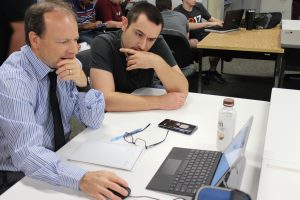Portfolios can help students get hired
From Spring 2019 to Fall 2021, the National CTC led a pilot program to determine whether applicants that go into a job interview with an e-portfolio of their work stand a better chance of getting hired than those without an e-portfolio. Eight colleges participated, teaching the same content across multiple classes. Faculty and students were surveyed following the terms and student employment trends were tracked longitudinally.
Results suggest that most faculty and students found this content valuable, easy to implement as course modules, and helpful in boosting student confidence in their work. Further, students who received this content did get hired into IT jobs more often than students from the “control” group who did not receive the content.

An 11-page summary report has been prepared that includes details on the pilot project’s content, specific findings of the work (including results from student and faculty surveys), impact tracking related to student hiring, and logistical “lessons learned” from managing the project. Download the report here.
During the project, a number of supplemental videos were created to support the effort. Faculty and students may find these six videos helpful.
“Student Portfolio Pilot Project Overview” (4 minutes), created by CTC staff, intended for faculty members joining the pilot project
“Value of e-Portfolios” (1 minute), a testimonial by IT instructor Louise Kowalski, intended for classroom use.
“Value of LinkedIn” (1 minute), a testimonial by IT instructor Louise Kowalski, intended for classroom use.
“IT Portfolio Redoux” (20 minutes), presented by Collin College’s Tara Lewis and Jana Nixon, discussed strategies and best practices to help students develop and curate e-portfolios of their work.
“Avoiding LinkedIn Blunders” (28 minutes), presented by Dr. Ruby Daniels from Texas A&M University San Antonio, discussed best practices for students to employ on LinkedIn to improve transition from college to career.
“Perspectives on Using Student Portfolios in Job Interviews” (5 minutes), interviews with four IT technical executives explaining how students might effectively leverage their e-portfolio once they’re in the room at a job interview
The “lessons learned” – informal findings and observations identified by CTC grant staff and participating faculty – should be considered by anyone attempting to replicate the portfolio project. Below are a few of those lessons. More can be found in the summary document.
* There is no easy way to track students once they graduate. Only one of colleges participating in the portfolio project had a pre-existing system in place to effectively survey graduates. For the others, it was a more time-intensive effort relying on both personal follow-ups and LinkedIn searches.
* Researching what “gets” someone hired is a complex problem. There are many outside factors at work. That made it very hard to identify – even with all of the surveys and tracking the pilot project completed –how impactful the LinkedIn and e-portfolio lessons truly have been. They’ve surely helped, but how much?
* The LinkedIn and e-portfolio exercises worked better as a module inside a 16-week course. Those with 8-week courses had trouble squeezing this extra content in.
* E-portfolio lessons seemed to be better received by students closer to graduation. Some of the first-year students didn’t yet understand why job-seeking tools like LinkedIn and e-portfolios were relevant.
* The ideal method for incorporating LinkedIn and e-portfolio lessons is to introduce the concepts early in the program so students then have “shells” to fill as they take classes and gain skills and experience. This is the model that Louise Kowalski, the creator of these lessons, followed.
